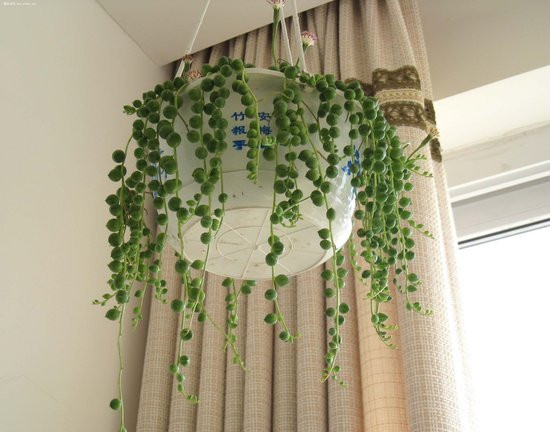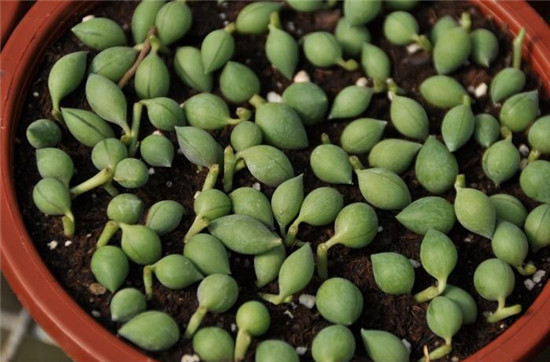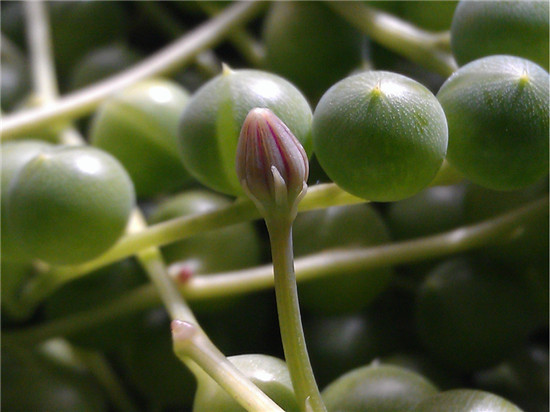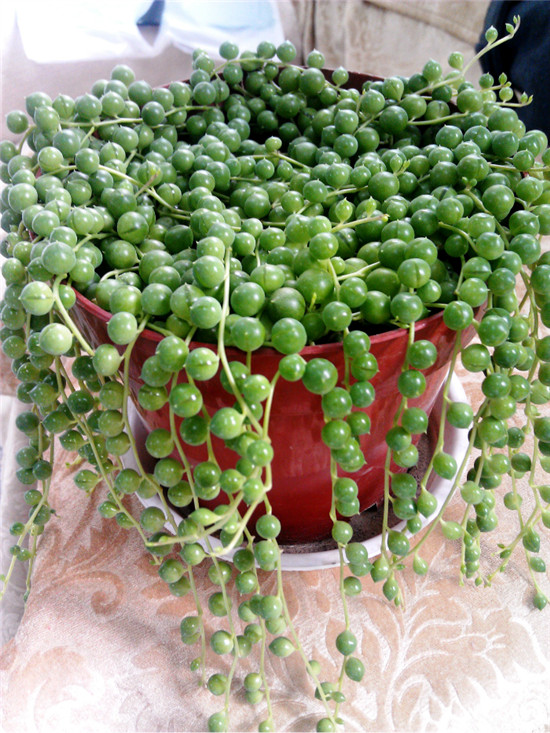Introduction to the culture method of Buddha-bead orchid
Buddha bead hanging orchid is what we often call pearl hanging orchid, perhaps many people do not know very much about the breeding method of Buddha pearl hanging orchid, then let's go and have a look!

The characteristics of Buddha beads and orchids
Buddha beads, also known as emerald beads, is a very common succulent plant. Except for those with "brocade", there are generally two kinds on the market: one is round and the other is teardrop-shaped. Because of the different names in different places, the common names are "pearl hanging orchid, Buddha bead and lover's tears".
Pearl orchid prefers loose and fertile soil rich in organic matter. It grows best in the environment of warmth, high humidity and strong scattered light. High temperature and high humidity should be avoided in summer, otherwise it is easy to rot stems and die. Potted flowers can be cultivated in the shade of rain protection. After autumn, the plants will resume growth, increase light and topdressing liquid fertilizer.

The culture method of Buddha bead orchid
1. Methods of reproduction
The propagation method of Buddha-bead orchid is mostly cymbidium insertion, which can trim the branches and leaves, each section is 8-10 cm, and then insert it into the basin soil, half-covered, the humidity is controlled between 50% and 60%, and take root in 10 days to half a month, supplemented by careful care in order to survive. At this time, it is most beneficial to plant growth to strictly control the amount of water and keep the pot soil in the state between dry and wet.
2. Cultivation and management
Dry rather than wet is one of the key points in the cultivation of Cymbidium. In addition, it is also extremely important to apply thin fertilizer frequently. The so-called dry rather than wet is because the orchid from southern Africa likes a warm environment and is more drought-resistant than waterlogged, so it would rather be placed in a dry environment than stunted by too much watering. On the other hand, the frequent application of thin fertilizer says that fertilizer should be applied frequently, but each time it is light fertilizer, and one time it can not be fertilized too much, which leads to problems in its growth.

3. Pest prevention
In fact, there are few insect pests in Buddha bead orchids, but this is still the case. Generally speaking, the most common disease of Buddha bead orchid is aphid disease, which occurs in spring. When encountering this kind of phenomenon, it should be killed with 500 times omethoate. And in summer there will be mites, which can be killed 1000 times with triclofenac. When pests, pay attention to increase the humidity of the page, can reduce pests, in addition, ventilation facilities should also be in place.
Matters needing attention in the culture of Buddha bead orchid
1. Because the orchid is also fleshy and juicy, it is more drought-resistant. In the process of cultivation, we should remember the principle that watering should be dry rather than wet, which is one of the keys to the success of breeding Cymbidium. It can spray water for leaves and vines when the weather is dry, so it can make up for the lack of water and keep the beads green and full. as the orchid likes semi-shade, exposure is likely to burn it, and its growth is not strong when the light is too strong.
2. The root system of Pearl Cymbidium is very shallow, which can be used for shallow pot planting. In general, we can use tiles to cover the bottom hole and cover a layer of cinder or coarse sand to increase the air permeability and filtration of the soil. Soil we'd better use rotten leaf soil to mix with a certain amount of sand.

3. The most suitable temperature for a warm and humid orchid is between 20 and 28 degrees. It grows slowly at both high and low temperatures, especially when it reaches 30 degrees, when the orchid is almost dormant. At this time, remember to give him less fertilizer and less watering, otherwise it will easily cause its roots to rot.
4. If it is in the peak season of the growth of Cymbidium, it should be applied thin and frequently, often spraying on the leaf will help the pearl body to become more green and hypertrophic, and better improve its ornamental value.
5. In fact, pearl orchid is rarely harmed by diseases and insects, but there are aphids in spring. Generally speaking, as long as you keep the ventilation and increase the humidity of the leaves, you can reduce the infection of mites.
The above is the whole content of the introduction of the breeding methods of Buddha beads and orchids that I have summarized for you. I hope this article can help you all. Please continue to follow us.
Related
- Wuhan Hospital Iron Tree Blooming Result Was Instantly Frightened by the Gardener Master
- Which variety of camellia is the most fragrant and best? Which one do you like best?
- What is the small blue coat, the breeding methods and matters needing attention of the succulent plant
- Dormancy time and maintenance management of succulent plants during dormancy
- Minas succulent how to raise, Minas succulent plant pictures
- What are the varieties of winter succulent plants
- How to raise succulent plants in twelve rolls? let's take a look at some experience of breeding twelve rolls.
- Attention should be paid to water control for succulent plants during dormant period (winter and summer)
- Watering experience of twelve rolls of succulent plants
- Techniques for fertilizing succulent plants. An article will let you know how to fertilize succulent plants.



